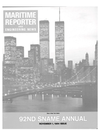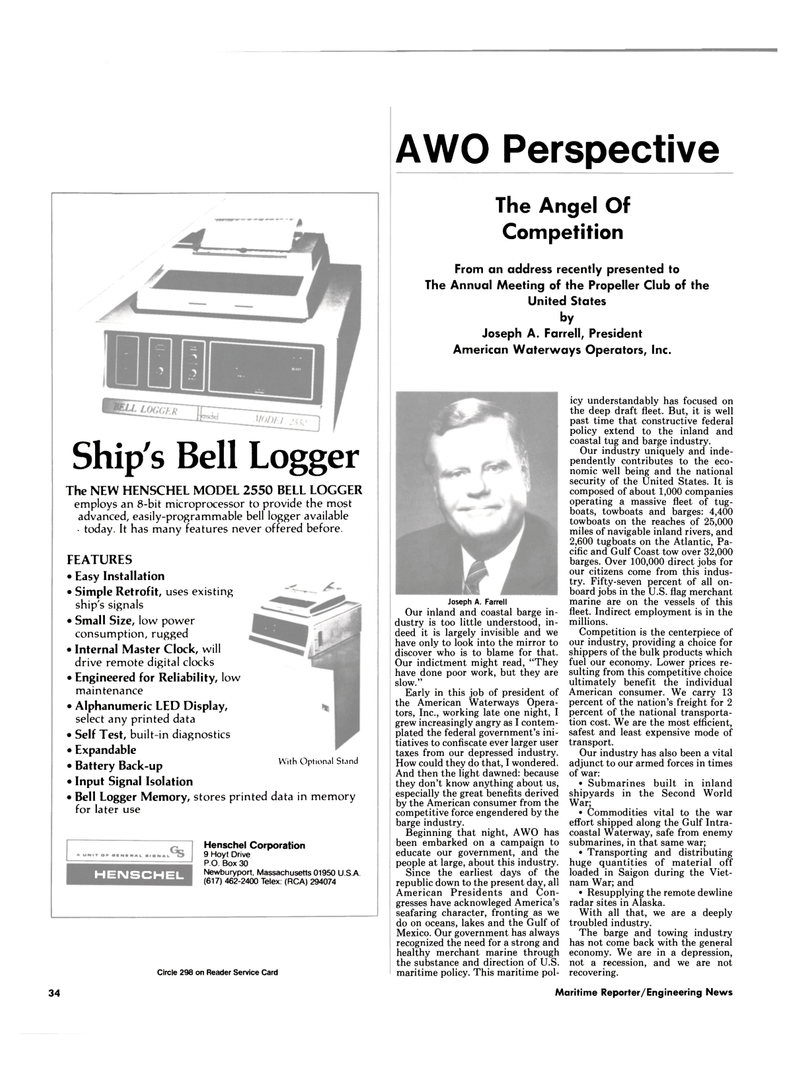
Page 30: of Maritime Reporter Magazine (November 1984)
Read this page in Pdf, Flash or Html5 edition of November 1984 Maritime Reporter Magazine
Ship's Bell Logger
The NEW HENSCHEL MODEL 2550 BELL LOGGER employs an 8-bit microprocessor to provide the most advanced, easily-programmable bell logger available • today. It has many features never offered before.
FEATURES • Easy Installation • Simple Retrofit, uses existing ship's signals • Small Size, low power consumption, rugged • Internal Master Clock, will drive remote digital clocks • Engineered for Reliability, low maintenance • Alphanumeric LED Display, select any printed data • Self Test, built-in diagnostics • Expandable • Battery Back-up • Input Signal Isolation • Bell Logger Memory, stores printed data in memory for later use
With Optional Stand
HENSCHEL
Henschel Corporation 9 Hoyt Drive
P.0 Box 30
Newburyport, Massachusetts 01950 U.S.A. (617) 462-2400 Telex: (RCA) 294074
Circle 298 on Reader Service Card
AWO Perspective
The Angel Of
Competition
From an address recently presented to
The Annual Meeting of the Propeller Club of the
United States by
Joseph A. Farrell, President
American Waterways Operators, Inc. icy understandably has focused on the deep draft fleet. But, it is well past time that constructive federal policy extend to the inland and coastal tug and barge industry.
Our industry uniquely and inde- pendently contributes to the eco- nomic well being and the national security of the United States. It is composed of about 1,000 companies operating a massive fleet of tug- boats, towboats and barges: 4,400 towboats on the reaches of 25,000 miles of navigable inland rivers, and 2,600 tugboats on the Atlantic, Pa- cific and Gulf Coast tow over 32,000 barges. Over f00,000 direct jobs for our citizens come from this indus- try. Fifty-seven percent of all on- board jobs in the U.S. flag merchant marine are on the vessels of this fleet. Indirect employment is in the millions.
Competition is the centerpiece of our industry, providing a choice for shippers of the bulk products which fuel our economy. Lower prices re- sulting from this competitive choice ultimately benefit the individual
American consumer. We carry 13 percent of the nation's freight for 2 percent of the national transporta- tion cost. We are the most efficient, safest and least expensive mode of transport.
Our industry has also been a vital adjunct to our armed forces in times of war: • Submarines built in inland shipyards in the Second World
War; • Commodities vital to the war effort shipped along the Gulf Intra- coastal Waterway, safe from enemy submarines, in that same war; • Transporting and distributing huge quantities of material off loaded in Saigon during the Viet- nam War; and • Resupplying the remote dewline radar sites in Alaska.
With all that, we are a deeply troubled industry.
The barge and towing industry has not come back with the general economy. We are in a depression, not a recession, and we are not recovering.
Joseph A. Farrell
Our inland and coastal barge in- dustry is too little understood, in- deed it is largely invisible and we have only to look into the mirror to discover who is to blame for that.
Our indictment might read, "They have done poor work, but they are slow."
Early in this job of president of the American Waterways Opera- tors, Inc., working late one night, I grew increasingly angry as I contem- plated the federal government's ini- tiatives to confiscate ever larger user taxes from our depressed industry.
How could they do that, I wondered.
And then the light dawned: because they don't know anything about us, especially the great benefits derived by the American consumer from the competitive force engendered by the barge industry.
Beginning that night, AWO has been embarked on a campaign to educate our government, and the people at large, about this industry.
Since the earliest days of the republic down to the present day, all
American Presidents and Con- gresses have acknowleged America's seafaring character, fronting as we do on oceans, lakes and the Gulf of
Mexico. Our government has always recognized the need for a strong and healthy merchant marine through the substance and direction of U.S. maritime policy. This maritime pol- 34 Maritime Reporter/Engineering News

 29
29

 31
31
